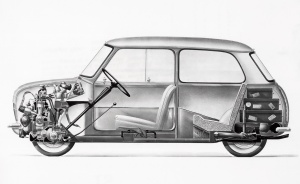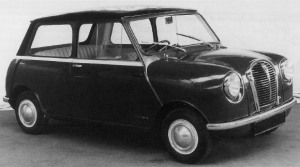
The word “mini” usually refers to something small or tiny, but in 1959 this word would become the name of a car that would shake up the automotive industry and the culture of the car market. Although Mini started as a name of a car in UK, eventually it ended up to be a Brand of its own, under the BMW AG Group. But the story for this transition is quite interesting and long.
The idea
In the ’50s Arabs decided to control the majority of the oil supplies of the rest of the world. In 1957 the situation got out of control and Colonel Nasser decided to take over the Suez Canal and in the war started that time, the Arabs blew up the pipelines in Syria, which provided the 20% of the Britain’s petrol supply. The situation would be remembered as Middle East crisis and the result was a long journey for all the tankers around the Cape of Good Hope in South Africa, and also great oil shortages in UK.
During this Middle East crisis the price of the petrol was raised and most of the people started to turn to smaller cars with lower fuel consumption. It was that era when Bubble Cars like the German Volkswagen Beetle, the French Citroen 2CV and the Italian FIAT 600 started evading in the UK and the rest of the European car market. In March 1957, Leonard Lord, the Chairman of Austin Motor Company based in Longbridge, UK, informed Alec Issigonis: “God damn these bloody awful bubble cars. We must drive them off the streets by designing a proper small car”, ordering him to create a smaller car for the UK market. Alec Issigonis was an engineer, working in Morris Motors Limited and Austin Motor Company, which merged in 1952 to British Motor Corporation Limited (BMC).
The development
In March 1957, Leonard Lord put the emphasis of the BMC new car development programme on the development of a new smaller car, designated as XC9003 or ADO15 Project and Alec Issigonis and his team of designers and engineers started working on that project. In July 1957 a wooden mock-up and several of the main mechanical items were ready for inspection from Leonard Lord. In October of the same year, two running prototypes were ready, one painted in bright orange colour.
According to John Culter, one of the members of the design team, Issigonis ended up with the final packaging with a radical solution:
‘The designs originated from putting seats on the shopfloor. Then we got all sorts of people to sit on them – secretaries from the offices, 6ft manual workers – and we got them to indicate what space they needed in the car. We measured how much space would be needed to open a map, where a pocket would be needed to stow the map. It is a very ergonomic car.’
This was essentially a human-centred concept: the car wasn’t developed for engineers nor for motoring enthusiasts but simple for people, giving to them the 80% of the space. The result was a car sized 10ft long by 4½ ft wide by 4 ft tall.
Beyond the general packaging, the car would implement some technical advances that would be radical for its era. One of them was the transverse engine, which made the car more packaging efficient and the front wheel drive. Another was the gearbox, that was mounted beneath the engine in an in-sump arrangement. The 10-inch wheels and tyres, specially developed by Dunlop, the monocoque shell, the rubber-cone suspension until September 1964 and from then the famous Hydrolastic suspension from Alex Moulton were also parts of the advances of the car. Two distinctive characteristics of Mini were the visible welded seams on the outside (A and C Pillars) and between the body and the floor, as well as the hinges of the doors and the boot lid, that were externally mounted.
The launch
The official launch of the car was on 26 August 1959 and it was priced under £500. The car was available to the public under both the brands of Austin and Morris with the names Austin Seven (usually mentioned as Se7en) and Morris Mini-Minor, as the BMC had separate dealerships for the two merged companies.
The name “Mini” was not used for the first time in cars as Sharps Commercials Limited built the three wheeled “Minicar” between 1949 and 1966, but it was Lord Nuffield, the Honorary President of BMC, who recommended the adoption of the name “Mini” for the ADO15, as he was always referred to Issigonis: ‘I have a hunch that “Mini” may well prove to be the catchword of the next decade.’
For the first year the sales were slow, as the press was sceptical for Mini, and it was considered as too clever and too small for the typical customer. Another problem was the fact that the accelerated development programme of the vehicle reduced its reliability.
Eventually, the car became a success with the 60’s and the 70’s to be its best selling era. The car was small enough to drive in the crowded streets of London, and the low price was another advantage as the income of the UK citizens increased. Driving a Mini was also considered fun as the engines became stronger. Soon afterwards its popularity, Mini became an icon as it was chosen by Celebrities and appeared in movies.
References:
- Setright, L. (1999) Mini – The design icon of a generation, London: Virgin Publishing Ltd. Comments: Great historic details on the development of Mini
- Nahum, A. (2004) Issigonis and the Mini, Cambridge: Icon Books Ltd. Comments: Great historic details for the development of the Mini.
- Adams, K.(2011) Essay : Mini – The world’s favourite small car? [online] available from http://www.aronline.co.uk/blogs/facts-and-figures/essays/essay-mini-%E2%80%93-the-worlds-favourite-small-car/ [19 October 2013] Comments: Includes historical details of Mini
- Adams, K.(2011) The cars : Mini development history, part 1 [online] available from http://www.aronline.co.uk/blogs/cars/mini-classic/the-cars-mini-development-history-part-1/ [19 October 2013] Comments: Includes historical details of Mini
- Adams, K.(2011) The cars : Mini development history, part 2 [online] available from http://www.aronline.co.uk/blogs/cars/mini-classic/the-cars-mini-development-history-part-2/ [19 October 2013] Comments: Includes historical details of Mini
- Avarvarii, A. (2006) 1959 – 2006 The History of Mini [online] available from http://www.topspeed.com/cars/mini/1959-2006-the-history-of-mini-ar10921.html [19 October 2013] Comments: Included interesting historical details and plenty of photographs and two short video documentaries.
- Wikipedia (2013) Mini [online] available from http://en.wikipedia.org/wiki/Mini [19 October 2013] Comments: Includes historical details of Mini such as the Design and Development and details for the Marks of Mini from 1959 to 2000.
- Mini online Museum (2010) Mini History [online] available from http://www.minionlinemuseum.com/mini_history.html [19 October 2013] Comments: Interesting approach in History and detailed information.



